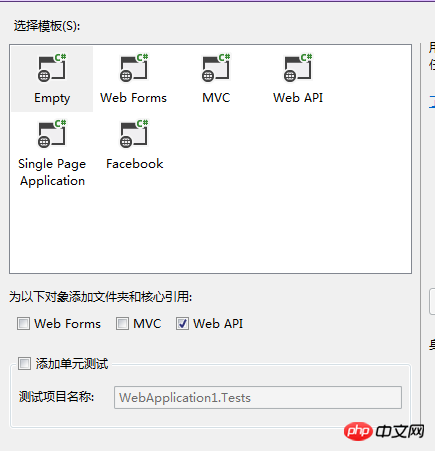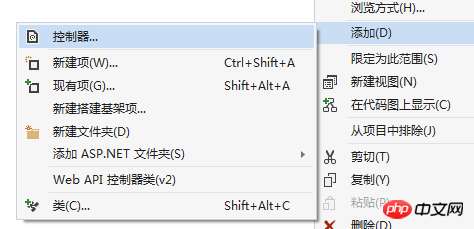
本篇文章主要介绍了asp.net MVC下使用rest的方法,小编觉得挺不错的,现在分享给大家,也给大家做个参考。一起跟随小编过来看看吧
前言
最近做了下个MVC的项目,需要用到rest接口,与java写的应用程序通信,包括数据的接收和发送,那么我将用实用的角度来全面的讲解一下它的使用方法
一、创建rest服务
首先创建一个Asp.Net Web应用程序(我这里用的是Visual Studio 2013,它已经内置了Web API2)。

在出来的模板中选择Empty(空项目),并勾选WebAPI。点击确定后,就创建了一个空的WebAPI服务。

此时只有一个空项目,还没有任何功能,在进行下一步之前,首先我们来看一下REST的基本操作模型,大致可以分为如下四种:
POST — 创建资源
GET — 检索资源
PUT — 更新资源
DELETE — 删除资源
非常经典的CRUD模型。在Web API中实现这样一个的模型是非常简单的,直接使用向导建一个Controller即可


如果用传统的向导,记得把向导后面的那个1给去掉:
默认的模板内容如下:
public class ValuesController : ApiController
{
// GET api/<controller>
publicIEnumerable<string> Get()
{
returnnewstring[] { "value1", "value2" };
}
// GET api/<controller>/5
publicstring Get(int id)
{
return"value";
}
// POST api/<controller>
publicvoid Post([FromBody]string value)
{
}
// PUT api/<controller>/5
publicvoid Put(int id, [FromBody]string value)
{
}
// DELETE api/<controller>/5
publicvoid Delete(int id)
{
}
}这其实已经帮我们实现了一个最基本的服务了,这样别人就可以访问我们的服务中的方法
二、调用其它应用程序的rest服务
1、RestClient类
为了便于使用,我们需要封装客房端的rest类,话不多说,我们直接上这个类的代码:
using System;
using System.Collections.Generic;
using System.IO;
using System.Linq;
using System.Net;
using System.Text;
using System.Web;
namespace OilDigital.A2_A27.Web
{
public class RestClient
{
public string EndPoint { get; set; } //请求的url地址
public HttpVerb Method { get; set; } //请求的方法
public string ContentType { get; set; } //格式类型:我用的是application/json,text/xml具体使用什么,看需求吧
public string PostData { get; set; } //传送的数据,当然了我使用的是json字符串
public RestClient()
{
EndPoint = "";
Method = HttpVerb.GET;
ContentType = "application/x-www-form-urlencoded";
PostData = "";
}
public RestClient(string endpoint)
{
EndPoint = endpoint;
Method = HttpVerb.GET;
ContentType = "application/json";
PostData = "";
}
public RestClient(string endpoint, HttpVerb method)
{
EndPoint = endpoint;
Method = method;
ContentType = "application/json";
PostData = "";
}
public RestClient(string endpoint, HttpVerb method, string postData)
{
EndPoint = endpoint;
Method = method;
ContentType = "application/json";
PostData = postData;
}
public RestClient(string endpoint, HttpVerb method, string postData, string contentType)
{
EndPoint = endpoint;
Method = method;
ContentType = contentType;
PostData = postData;
}
public string MakeRequest()
{
return MakeRequest("");
}
public string MakeRequest(string parameters)
{
var request = (HttpWebRequest)WebRequest.Create(EndPoint + parameters);
request.Method = Method.ToString();
request.ContentType = ContentType;
if (!string.IsNullOrEmpty(PostData) && Method == HttpVerb.POST)//如果传送的数据不为空,并且方法是post
{
var encoding = new UTF8Encoding();
var bytes = Encoding.GetEncoding("iso-8859-1").GetBytes(PostData);//编码方式按自己需求进行更改,我在项目中使用的是UTF-8
request.ContentLength = bytes.Length;
using (var writeStream = request.GetRequestStream())
{
writeStream.Write(bytes, 0, bytes.Length);
}
}
if (!string.IsNullOrEmpty(PostData) && Method == HttpVerb.PUT)//如果传送的数据不为空,并且方法是put
{
var encoding = new UTF8Encoding();
var bytes = Encoding.GetEncoding("iso-8859-1").GetBytes(PostData);//编码方式按自己需求进行更改,我在项目中使用的是UTF-8
request.ContentLength = bytes.Length;
using (var writeStream = request.GetRequestStream())
{
writeStream.Write(bytes, 0, bytes.Length);
}
}
using (var response = (HttpWebResponse)request.GetResponse())
{
var responseValue = string.Empty;
if (response.StatusCode != HttpStatusCode.OK)
{
var message = String.Format("Request failed. Received HTTP {0}", response.StatusCode);
throw new ApplicationException(message);
}
// grab the response
using (var responseStream = response.GetResponseStream())
{
if (responseStream != null)
using (var reader = new StreamReader(responseStream))
{
responseValue = reader.ReadToEnd();
}
}
return responseValue;
}
}
}
public enum HttpVerb
{
GET, //method 常用的就这几样,当然你也可以添加其他的 get:获取 post:修改 put:写入 delete:删除
POST,
PUT,
DELETE
}
}2、RestClient类使用
有了这个类后我们就很方便的去调用别人的rest服务了,使用方法如下:
①,基本的调用:
var client = new RestClient(); string endPoint = @"http:\\myRestService.com\api\"; var client = new RestClient(endPoint); var json = client.MakeRequest();
②,如果你想带入参数
var json = client.MakeRequest("?param=0");③,使用最多的方式
var client = new RestClient();
client.EndPoint = @"http:\\myRestService.com\api\"; ;
client.ContentType = "application/json";
client.Method = HttpVerb.POST;
client.PostData = "{postData: value}";
var json = client.MakeRequest();三、我自己项目中的使用
1、首先我测试了一下,我调用我自己的rest服务的带参的get方法,当然我这里传的参数直接写在url的后面在,参数形式是string,所以接收的get方法的形参也要改成string,这样你就
可以接收到传过去的参数了。当然别人应用程序也是可以调的。只要把url给他就行了。
/// <summary>
/// 从接口中获取当前用户所有信息
/// </summary>
/// <param name="userId">用户ID</param>
/// <returns>json对象</returns>
public string GetCurrentUserInfo()
{
string userId = GetCurrentUserId();
string endPoint = "http://localhost:100/Api/RestService/"+userId;
var client = new RestClient(endPoint);
var userInfo = client.MakeRequest();
return userInfo;
}2、接下来,我要开始试用java写的应用程序下的rest服务了,我通过我传过去的用户ID获取到了用户的所有信息,当然我在项目中使用了缓存技术,还将返回回来的json字符串转换成了json对象,以便我后面好用linq对其进行操作,关于linq to json 可以参考我的linq专题相关文章 ,我在项目中的代码是酱子的:
/// <summary>
/// 从接口中获取用户所有信息
/// </summary>
/// <param name="userId">用户ID</param>
/// <returns></returns>
public static JObject CacheUser()
{
try
{
string currentUser = GetCurrentUserId();
if (HttpRuntime.Cache.Get("user$" + GetCurrentUserId()) == null)
{
string endPoint = "http://66.66.66.666:6666/DASBASE/restServices/dataCollectionService/getUserPermissions";
string postData = "jsonData={\"userCode\": \"kfry\",\"systemId\": \"1E1A7AC94BFC41D4BEBED8942EB69689\"}";
var client = new RestClient(endPoint, HttpVerb.POST, postData, "application/x-www-form-urlencoded");
var u = client.MakeRequest();
JObject userInfo = JObject.Parse(u);
//插入缓存
HttpRuntime.Cache.Insert("user$" + currentUser, userInfo, null, System.DateTime.UtcNow.AddMinutes(30), TimeSpan.Zero);
}
return (JObject)HttpRuntime.Cache.Get("user$" + GetCurrentUserId());
}
catch (Exception ex)
{
throw new ApplicationException("获取用户信息出错:"+ex.Message);
}
}以上がasp.net MVC で Rest を使用する方法の紹介の詳細内容です。詳細については、PHP 中国語 Web サイトの他の関連記事を参照してください。